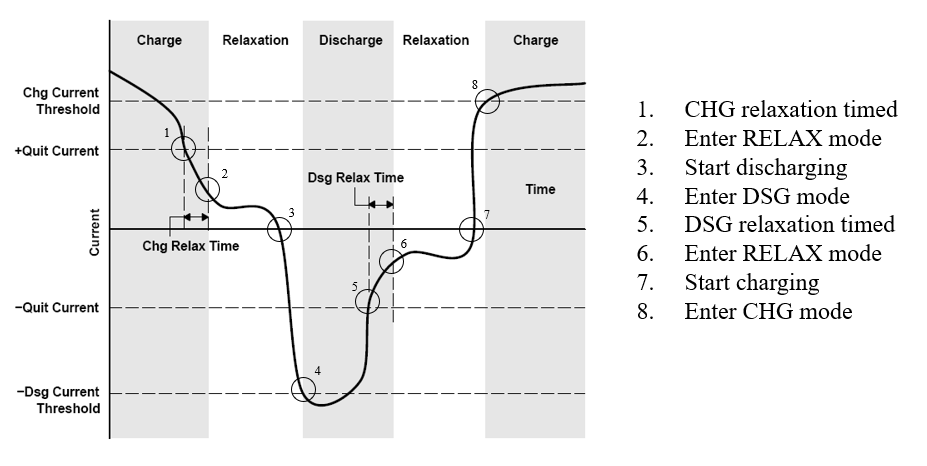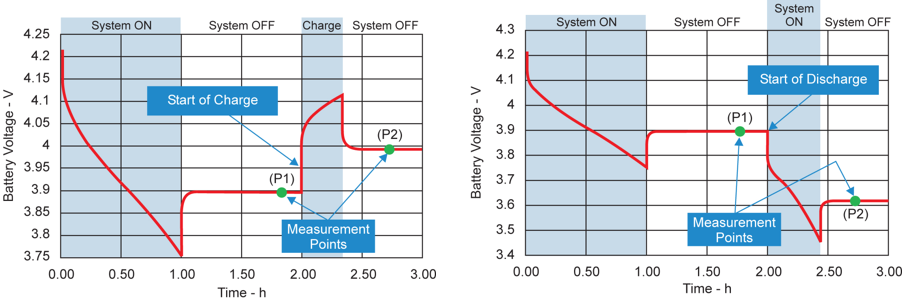SLUAAR3 December 2023 BQ27426 , BQ27427 , BQ27Z561 , BQ27Z746 , BQ28Z610 , BQ34Z100 , BQ40Z50 , BQ40Z80
6 Impedance Track
Impedance Track vastly expands on the previous algorithms discussed by combining aspects of coulomb counting and Voltage + IR Correction. Impedance track uses many different factors to calculate SOC including: Depth of Discharge (DOD), total chemical capacity (Qmax), internal battery resistance dependence on DOD, current load, and temperature.
First, Impedance Track determines whether the battery is currently in a charge, discharge, or relaxed state. Certain parameters need to be set in the gauge to differentiate between these three different states, including: Chg Current Threshold, Dsg Current Threshold, Quit Current, Chg Relax Time, and Dsg Relax Time.
 Figure 6-1 Example of Impedance Track
Mode Changes
Figure 6-1 Example of Impedance Track
Mode ChangesThe gauge updates the Chemical Depth of Discharge (DOD0) based on the OCV reading when the battery is in the relaxed state. DOD is found by correlating the present OCV and temperature with the predefined DOD(OCV,T) table. This table is specific for each different chemistry of each battery and is differentiated by the Chemistry ID. OCV reading occur when the rate of change in voltage is less than 4 microvolts per second. If the current during the OCV reading is non-zero, then an IR correction is done.
The gauge is able to update Qmax between two DOD reading made before and after a charge or discharge as shown in Figure 6-2. For Qmax to update, there needs to be more than a 37% change in charge based on the design capacity of the battery. If the gauge is making the first Qmax update, then there needs to be at least a 90% change in charge. Coulomb counting is used to determine the change in charge. Equation 2 shows how Qmax is calculated.
 Figure 6-2 Example of Qmax
Measurements
Figure 6-2 Example of Qmax
MeasurementsThe gauge is able to update the battery’s internal resistance table (Ra table) during the discharge of the battery. The internal resistance is calculated by finding the difference in present loaded voltage from the corresponding DOD point from the OCV(DOD,T) table all divided by the measured current. Equation 3 shows how the internal resistance is calculated.
The algorithm uses all the information above to run simulations based on the user programmed Load Select to calculate the SOC. The simulation calculates the remaining capacity (RemCap) once per second based on the passed charge, and FCC can update under certain circumstances. FCC can update during resistance grid-point update, during relaxation, or during the entry of charge or discharge.
Impedance Track offers many improvements over the previously discussed algorithms. Firstly, unlike coulomb counting /CEDV that require a full charge to initialize SOC, Impedance Track does not need to be fully charged to initialize SOC. Self-discharge is frequently compensated by OCV readings which allows the SOC accuracy to remain high, even when sitting idle for long periods of time. The internal resistance of the battery is constantly updating which allows for gauging error to remain small for aged cells, and there is not increased error when there is a high rate of discharge. Temperature compensated resistance updates allows for improved gauging accuracy at lower temperature where internal battery impedance is higher. Since Impedance Track constantly re-runs simulations, Full Charge Capacity (reported in mAh and Wh) is updated at critical points during the discharge. SoH is also continuously updated since Qmax and Ra table are always updating. SOC is able to be adjusted for discharge rate and temperature throughout the entire discharge of the battery.